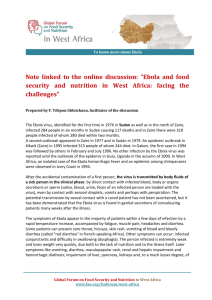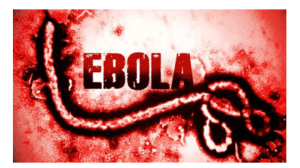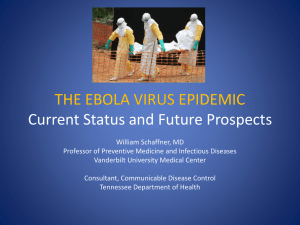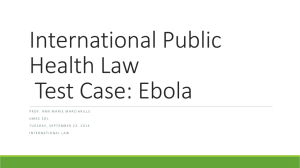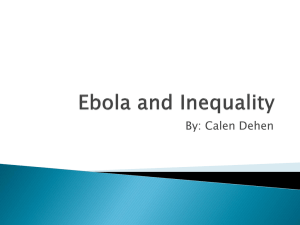medicine - NLCS Maths Department
advertisement
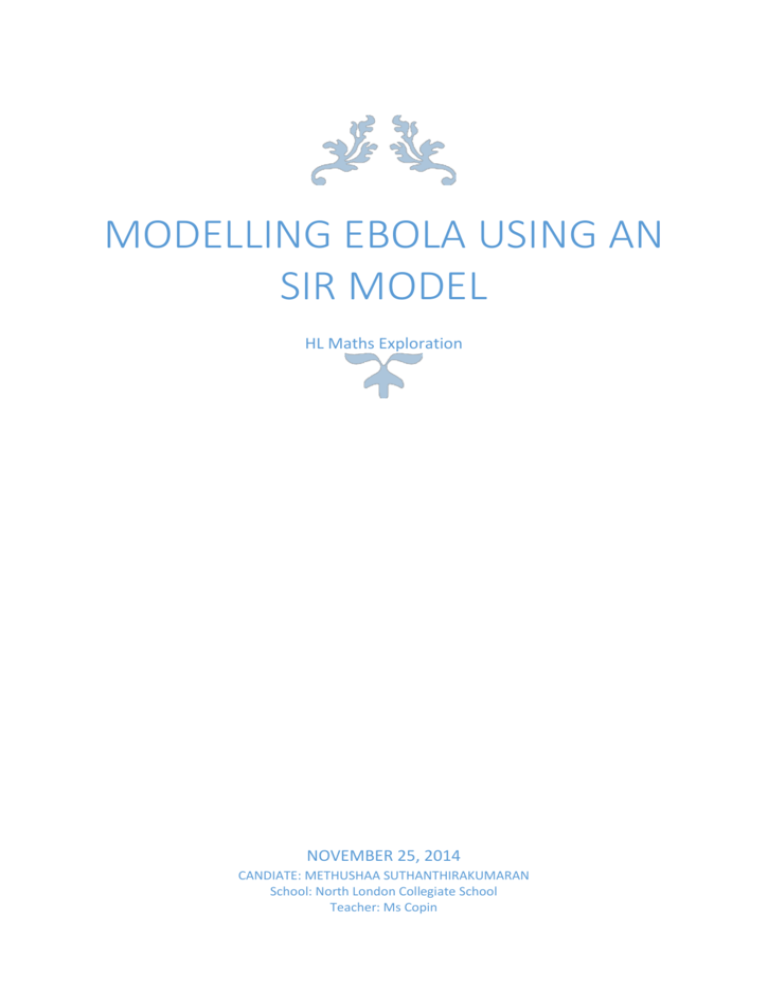
MODELLING EBOLA USING AN SIR MODEL HL Maths Exploration NOVEMBER 25, 2014 CANDIATE: METHUSHAA SUTHANTHIRAKUMARAN School: North London Collegiate School Teacher: Ms Copin Modelling Ebola using an SIR model 2014 Contents 1. Introduction and aim .......................................................................................................... 2 2. Common sense description of the SIR model .................................................................... 3 Parameterisation of the model .......................................................................................... 4 3. Running the SIR model on the initial figures of the Ebola Outbreak in Liberia in 2014 .. 6 Graphical interpretation .................................................................................................... 8 Validity of the model ...................................................................................................... 10 Advantages ..................................................................................................................... 10 Disadvantages ................................................................................................................. 11 4. Comparing the model to actual figures and trying to improve it ..................................... 12 5. Conclusion ....................................................................................................................... 15 6. Bibliography .................................................................................................................... 17 1 Modelling Ebola using an SIR model 2014 Using the SIR model for Ebola outbreaks 1. Introduction and aim The Ebola virus disease was first discovered in 1976 in the present Democratic Republic of Congo1. Since then, there have been many outbreaks, with the greatest being the current 2014 outbreak2 which has spread through many countries. Hoping to study medicine in the future and eventually becoming a doctor, I became fascinated with the repetition of the outbreak of Ebola and the fact that despite the advancements in technology, little was done in preparation for it. Therefore, by combining my interest in mathematics which lies in modelling functions along with curiosity for the repetition of the disease, I decided to model the Ebola Epidemics in Liberia in 2014 and Democratic Republic of Congo 1976 and compare their spread using an SIR3 model. An SIR model is an epidemiological model which measures the number of people infected with a particular disease over a period of time using three fundamental equations4. Therefore in doing so, I aim to develop my understanding on the mathematics of the SIR model and about its possible limitations for discussing the spread of the disease, in turn, this should shed light on the spread of Ebola. In order to do this, I will: Describe the SIR model Use the model on the initial data from the outbreak in Liberia 2014 Compare the model with real data Liberia 2014 1 "Ebola Virus Disease." WHO. N.p., n.d. Web. 17 Nov. 2014. "2014 Ebola Outbreak in West Africa." Centers for Disease Control and Prevention. Centers for Disease Control and Prevention, 06 Mar. 2015. Web. 07 Nov. 2014. 3 "Kermack-McKendrick Model." -- from Wolfram MathWorld. N.p., n.d. Web. 17 Nov. 2014. 4 "The Mathematics of Diseases." The Mathematics of Diseases. N.p., n.d. Web. 17 Nov. 2014. 2 2 Modelling Ebola using an SIR model 2014 2. Common sense description of the SIR model The SIR model is used to illustrate the transfer of the epidemic through the interaction of the following three different variables: 𝑆 = number of people that are susceptible to Ebola 𝐼 = number of people infected with Ebola 𝑅 = number of people recovered from Ebola with total immunity It makes sense to assume that a fixed population of 𝑁 people, whereby there are no births and deaths by natural cause, consists of the number of people susceptible plus the number of people infected plus number of people resistant: 𝑁 = 𝑆 + 𝐼 + 𝑅5 This is because the population is fixed and therefore, there are only three compartments in which the population may fit into. Thus, the total of the number of people susceptible infected and recovered in equivalent to the total population. The assumption that 𝑁 is fixed, with no births or deaths, makes sense given 60 days, although it is a simplification. These variables change over time, so I will define the variable 𝑡 = time in days. I will set 𝑡 = 0 at the start of August 2014. The model uses two parameters which can be used calibrate it, 𝛽 and 𝛾 with 𝛽, 𝛾 > 0. Given these parameters, the model uses 3 differential equations. These will be different numbers for any given disease and situation, and will depend on things like method of transmission, and the contact rate. I will calculate those later using actual data for the current Ebola epidemic mathematically, thought of as contrast of population, but I want to first give an idea of why these equations are true and what these might mean. Equation 1: 𝑑𝑆 𝑑𝑡 = − 𝛽𝐼𝑆6 𝑑𝑆 In Equation 1, 𝑑𝑡 means the rate of change of the number of people susceptible to the disease over 𝑑𝑆 time. 𝑑𝑡 decreases proportionally to 𝐼 because in order to become infected, you are no longer 5 Dolgoarshinnykh, Regina, Columbia University, Steven P. Lalley, and University Of Chicag. "Epidemic Modeling: SIRS Models." Epidemic Modeling: SIRS Models (n.d.): n. pag. Web. 6 "Modelling Infectious Diseases." IB Maths Resources from British International School Phuket. N.p., 17 May 2014. Web. 04 Nov. 2014. 3 Modelling Ebola using an SIR model 2014 susceptible to the diseases any more. Since the only way to leave the set of susceptible people is through becoming infected with the disease itself, therefore the number of people who are susceptible to the disease is determined by the number of people who are already susceptible, the number of individuals who are already infected and the amount of contact between the susceptible and infected. An assumption is made that every individual has the same probability of becoming infected with the disease. In real life, this is highly improbable and it is a limitation that I discuss later. The equation also decreases proportionally to 𝑆 because individuals are repeatedly being removed from the susceptible section and being transferred into the infectious section. Equation 2: 𝑑𝑅 𝑑𝑡 In equation 2, = 𝛾𝐼7 𝑑𝑅 𝑑𝑡 means the rate of change of the number of people recovered over time. This illustrates that the rate of the number of people recovering is dependent upon the number of people infected as in order to become recovered. This is because, in order to become recovered from a disease, one must have been infected at some point over a certain period of time and if the duration of time is shorter, then the rate of becoming infected increases. Therefore, this increases proportionally with the rate of the disease being infected. Equation 3: 𝑑𝐼 𝑑𝑡 = 𝛽𝐼𝑆 − 𝛾𝐼8 𝑑𝐼 In equation 3, 𝑑𝑡 means the rate of change of the number of people infected. This is dependent on the number of people susceptible and the number of people infected as well as the infection rate of the disease between the two compartments. As the population of 𝐼 increases, the population of 𝑆 𝑑𝐼 decreases, therefore the rate at which 𝑑𝑡 increases is inversely proportional to the 𝑆 because in order for there to be more infected people, there must be a decrease in the number of susceptible people. Thus, this equation is a consequence of the fact that: 𝑑𝐼 𝑑𝑡 = − 𝑑𝑆 𝑑𝑡 − 𝑑𝑅 𝑑𝑡 into which we can substitute equation 1 and 2. Parameterisation of the model In order to calculate 𝛽 (the rate of infection) and 𝛾 (the rate of recovery), it helps to define two more parameters. 7 "Modelling Infectious Diseases." IB Maths Resources from British International School Phuket. N.p., 17 May 2014. Web. 04 Nov. 2014. 8 "Modelling Infectious Diseases." IB Maths Resources from British International School Phuket. N.p., 17 May 2014. Web. 04 Nov. 2014. 4 Modelling Ebola using an SIR model 2014 𝐷 = Duration of disease for those recovered 𝑀 = Mortality rate for those who die per day (0.7 for Ebola) This leads to two further equations. Equation 4: 𝛾 = 1 9 𝐷 In equation 4, the rate at which the disease is spread can be found by dividing 1 by the duration of the disease. This is because; a certain individual can only experience one recovery in a given period of time. For example if the duration of the infective period is 10 days, then the rate at which those who are infected become recovered is: 1 10 = 0.1 = 10% 5 Equation 5: 𝛽 = 𝑀 10 𝑆 Equation 5 illustrates that the infection rate of the disease is dependent upon the mortality rate and the number of people susceptible to the disease. It demonstrates the rate at which the disease passes from a susceptible individual to an infected individual. The value for 𝛽 always lies between 0 and 1, because a value of 1 suggests 100% infection rate and a value of 0 suggests 0% infection rate. For example, if the mortality rate of the population is 50% and the number of people susceptible is 100, then the rate in infection will be calculated as follows: 𝛽= 0.5 = 0.005 100 9 "Modelling Infectious Diseases." IB Maths Resources from British International School Phuket. N.p., 17 May 2014. Web. 04 Nov. 2014. 10 "The Spread Of Infectious Diseases." The British Medical Journal 2.1281 (1885): 108. Web. 5 Modelling Ebola using an SIR model 2014 3. Running the SIR model on the initial figures of the Ebola Outbreak in Liberia in 2014 If we now take the example of the Ebola outbreak in Liberia 2014, we can assign the parameters with the following values. The total population of Liberia, N = 429400011, and according to data from WHO12, the number of people infected, I = 84613 and the number of people dead is 48114. Seeing as R, includes the number of people who have received permanent immunity, this includes those who have died as they have permanent immunity, in addition to those who have recovered with permanent immunity. Therefore, number of people recovered 𝑅 = 481 + (0.3 × 846) = 735 I will now use this data to provide the parameters with the following values. 𝑁 = 4294000 𝐼 = 846 𝑅 = 735 Therefore, 𝑆 = 𝑁 − 𝐼 + 𝑅 = 4294000 − (735 + 846) = 4292419 The duration of the disease ranges from 2 to 18 days, therefore we could roughly estimate the duration of the disease at the midpoint, i.e. 10 days. 𝐷 = 10 𝛾= 1 = 0.1 10 According to WHO, the mortality rate of Ebola is 0.715 and the number of people susceptible is 4292419. Therefore from equation 5, 𝛽 (the rate of infection) = 11 0.7 4292419 = 1.63 × 10−7 "Appendix: Additional Results and Technical Notes for the EbolaResponse Modeling Tool." Centers for Disease Control and Prevention. Centers for Disease Control and Prevention, 23 Sept. 2014. Web. 08 Nov. 2014. 12 "Ebola Virus Disease Update - West Africa." WHO. N.p., n.d. Web. 08 Nov. 2014 13 "Ebola Virus Disease Update - West Africa." WHO. N.p., n.d. Web. 24 Nov. 2014. 14 "Ebola Virus Disease Update - West Africa." WHO. N.p., n.d. Web. 24 Nov. 2014. 15 "WHO Finds 70 Percent Ebola Mortality Rate." - Africa. N.p., n.d. Web. 08 Nov. 2014. 6 Modelling Ebola using an SIR model 2014 In order to use the SIR model to predict the evolution of the disease, it would be helpful if we could solve the system of differential equations. Unfortunately, we cannot completely solve these equations with an explicit formula solution16. Therefore, I will use a numerical approach, as follows. For each day, I will calculate the values of 𝑑𝑆 𝑑𝐼 , 𝑑𝑡 𝑑𝑡 𝑑𝑅 𝑎𝑛𝑑 𝑑𝑡 using equations 1, 2 and 3. Then assume that the 𝑆 value for the following day is the 𝑑𝑆 previous 𝑆 value + 𝑑𝑡 for that point in time. I will do this explicitly for the transition from t = 0 to t = 1. Using equations 1, 2 and 3 from earlier, the following values for the three rates of change of S, I and R can be calculated. 𝑑𝑆 | 𝑑𝑡 𝑡=0 = (− 1.63 × 10−7 ) × 846 × 4292419= -581 𝑑𝐼 | 𝑑𝑡 𝑡=0 = (1.6 × 10−7 ) − (0.1 × 846) = 496 𝑑𝑅 | 𝑑𝑡 𝑡=0 = 0.1 × 846 = 85 Therefore, at t=1, S = 4292419 − 581 = 4291838 I will now use excel to do this over a two month period, by putting in the formulae in the following way. I defined 𝛾 in as g in cell I1 and 𝛽 as b in cell J3: A B C D E F G H I J 1 T S I R dS/dt dI/dt dR/dt gamma 2 T B2 C2 D2 E2 F2 G2 beta b -g*I3*B3 B*I3*B3 – g*I3 g*I3 S+I+R B2 + C2 + D2 B3+E3+C2+ F2+D2+G2 3 t+1 B3+E3 C2+F2 D2+G2 g b g This generates the following table: t 0 1 2 3 4 5 6 7 8 9 10 11 12 Susceptible S Infected I 4292419 4291838 4290916 4289454 4287134 4283457 4277631 4268406 4253821 4230814 4194644 4138095 4050446 16 Recovered R 846 1342 2130 3379 5361 8502 13478 21355 33804 53432 84258 132381 206792 ds/dt 735 820 954 1167 1505 2041 2891 4239 6374 9755 15098 23524 36762 dI/dt -581 -922 -1462 -2319 -3677 -5827 -9225 -14585 -23008 -36169 -56549 -87649 -134016 dr/dt 496 788 1249 1981 3141 4977 7877 12449 19627 30826 48123 74411 113337 S+I+R 85 134 213 338 536 850 1348 2136 3380 5343 8426 13238 20679 Matemàtic, Materials. "MAT 2." Publicació Electrònica De Divulgació Del Departament De Matemàtiques De La Universitat Autònoma De Barcelona (n.d.): n. pag. Www.mat.uab.cat/matmat. 01 July 2013. Web. 12 Nov. 2014. 7 4294000 4294000 4294000 4294000 4294000 4294000 4294000 4294000 4294000 4294000 4294000 4294000 4294000 Modelling Ebola using an SIR model 2014 13 14 15 16 17 18 19 20 21 22 23 24 25 26 27 28 29 30 31 32 33 34 35 36 37 38 39 40 41 42 43 44 45 46 47 48 49 50 51 52 53 54 55 56 57 58 59 60 3916430 3715828 3425269 3024975 2513073 1924493 1337601 844874 498167 286544 167290 101437 64431 42895 29843 21608 16213 12556 10000 8164 6812 5796 5016 4409 3927 3541 3228 2971 2757 2579 2429 2302 2193 2100 2019 1950 1889 1837 1791 1750 1714 1683 1655 1631 1609 1589 1572 1557 320129 488718 730405 1057658 1463795 1905995 2302288 2564786 2655015 2601136 2460277 2280102 2089097 1901724 1724604 1560378 1409735 1272418 1147733 1034796 932668 840418 757155 682047 614324 553277 498263 448694 404038 363813 327581 294951 265564 239101 215271 193814 174493 157096 141433 127330 114633 103201 92909 83642 75300 67789 61028 54940 Graphical interpretation From this table, we can plot S, I, R against t. 8 57441 89454 138326 211366 317132 463512 654111 884340 1140819 1406320 1666434 1912461 2140471 2349381 2539554 2712014 2868052 3009025 3136267 3251040 3354520 3447787 3531828 3607544 3675749 3737181 3792509 3842335 3887205 3927608 3963990 3996748 4026243 4052799 4076709 4098236 4117618 4135067 4150777 4164920 4177653 4189116 4199436 4208727 4217091 4224621 4231400 4237503 -200602 -290559 -400294 -511902 -588580 -586892 -492727 -346707 -211622 -119255 -65853 -37006 -21537 -13052 -8235 -5395 -3657 -2556 -1836 -1352 -1017 -779 -608 -481 -386 -313 -257 -213 -178 -150 -127 -109 -93 -80 -70 -60 -53 -46 -41 -36 -31 -28 -25 -22 -19 -17 -15 -14 168589 241687 327253 406137 442200 396292 262498 90229 -53879 -140859 -180175 -191004 -187373 -177121 -164226 -150643 -137316 -124686 -112937 -102128 -92250 -83262 -75108 -67724 -61046 -55014 -49569 -44656 -40226 -36231 -32631 -29386 -26463 -23830 -21458 -19321 -17397 -15663 -14103 -12697 -11432 -10292 -9266 -8342 -7511 -6762 -6087 -5480 32013 48872 73041 105766 146379 190600 230229 256479 265501 260114 246028 228010 208910 190172 172460 156038 140973 127242 114773 103480 93267 84042 75716 68205 61432 55328 49826 44869 40404 36381 32758 29495 26556 23910 21527 19381 17449 15710 14143 12733 11463 10320 9291 8364 7530 6779 6103 5494 4294000 4294000 4294000 4294000 4294000 4294000 4294000 4294000 4294000 4294000 4294000 4294000 4294000 4294000 4294000 4294000 4294000 4294000 4294000 4294000 4294000 4294000 4294000 4294000 4294000 4294000 4294000 4294000 4294000 4294000 4294000 4294000 4294000 4294000 4294000 4294000 4294000 4294000 4294000 4294000 4294000 4294000 4294000 4294000 4294000 4294000 4294000 4294000 Modelling Ebola using an SIR model 2014 SIR Model Model for for the theEbola Ebolaoutbreak outbreakininLiberia, Liberia,August August2014 2014 4500000 4500000 Number of people ofpeople Number 4000000 4000000 3500000 3500000 3000000 3000000 2500000 2500000 SS 2000000 2000000 I 1500000 1500000 1000000 1000000 500000 500000 0 R R 0 N N 0 0 10 20 30 40 50 10 20 30 40 50 Time over aa two twomonth monthperiod period Time(days) (days) from from August August 2014 2014 over 60 60 As expected, this shows that initially, the number of people infected increases steeply, however, over a longer period of time, the numbers eventually decrease. This happens simultaneously as the number of people recovered increases because as those infected decreases, they are being transferred into the recovered category. The main reason is due to the increased awareness of the disease leasing to further medical support being given in order to help combat the transmission of the disease. Furthermore, an increased awareness results in more people being aware of methods of protection. The steep increase in the beginning of the first 15 days is most likely to be due to the great uncertainty that lied with Ebola allowing a greater rate of transmission. The peak of the graph illustrates the maximum number of people ever to be infected and after this point, there is a transition whereby the numbers decrease. The number of people susceptible to the disease remains constant for the first 10 days, and then it steeply decreases to create a negative sigmoidal curve. This means that it is shaped like the letter S, but in reverse. It must be noted that the number of people never reaches 0, and only tends towards it allowing the epidemic to reoccur in the future. The only way for the number of susceptible to reach 0 is through the vaccination as this acts as a vehicle to remove the disease from the population. The number of people susceptible remains constant at the beginning, which is similar to the small increase in the number of people infected. However, as there are more people infected, there is a steep decline in the number of people susceptible to the disease. This is because being the number of people infected comes from the number of people susceptible and they are connected. Therefore, as the number of people infected begins to decline, the number of people susceptible begins to level off. This is due to the fact that everyone infected is eventually becoming recovered, thus reducing the numbers of those who are infected. Therefore, there is very little change in the number of people susceptible to the disease towards the end of the two month period. 9 Modelling Ebola using an SIR model 2014 The number of people recovered from the disease, slowly increase at the beginning with the slow rate of infection. However, as the number of people infected increases dramatically, this leads to a consequent steep increase with the number of people recovered, until eventually levelling off simultaneously to the number of people susceptible. The line illustrating the number of people recovering increases concurrently as the number of people susceptible decreases. This is because susceptibility and recovery are inversely proportional to one another. However, the number of people recovered from the disease, never reaches the total population, and only tends towards it. Furthermore, this graph illustrates cumulative distributions through the positive sigmoidal curve on the graph. The graph also shows that the total population remains constant throughout the two month period via a linear correlation. This is because, as established earlier, 𝑁 = 𝑆 + 𝐼 + 𝑅 and in order to detect a change in something we need to differentiate it. In this case, the graph suggests no change, so the differentiation must be equivalent to 0. Therefore, (𝑆 + 𝐼 + 𝑅)′ = 𝑆 ′ + 𝐼 ′ + 𝑅 ′ and by substituting the differential equations 1, 2 and 3, we get the following: (𝑆 + 𝐼 + 𝑅)′ = − 𝛽𝐼𝑆 + 𝛾𝐼 + 𝛽𝐼𝑆 − 𝛾𝐼 = 0 Thus, there is no change in the population and it will remain constant in a given period of time. The graph is useful because it allows me to see the interaction between the different variables and it is interesting to relate it to differentiation to determine the changes over time. Validity of the model However, in order for the model to be valid and allow to inform government policy, it obviously needs to correspond fairly close to reality. Before checking against the graph, there are already clear advantages and disadvantages to this model: Advantages The advantages to the model include: 10 Modelling Ebola using an SIR model 2014 1. It is very quick to model the data having found the values for the respective parameters and transition probabilities to allow immediate assessment of the condition that is present. This results in instant evaluation of the situation as well as valid prediction of the spread of disease in the future. 2. The model is widely used and also widely understood by the medical community making it easier to explain the effects of the epidemic 3. This model is clear and easy to understand in order to distinguish between the number of people susceptible, infected and recovered 4. The mechanism to create the data is flexible, allowing it to be easily altered if certain values are incorrect or have changed 5. It is computationally cheap and there are other software available with very small time intervals allowing it to be more accurate which I could not complete in excel. Disadvantages The disadvantages to the model include: 1. The calculation of the beta values and gamma values are often inaccurate because small deviation from the ‘correct value’ can result in great changes in the overall model. For example, changing the gamma value from 0.1 to 0.3 can lead to the following changes: Gamma value of 0.1 Gamma value of 0.3 4500000 4500000 4000000 4000000 3500000 3500000 3000000 3000000 Number of 2500000 people 2000000 S Number of 2500000 people 2000000 S 1500000 R 1500000 1000000 R N 1000000 N I 500000 I 500000 0 0 0 10 20 30 40 50 Time (days) from August 2014 over a two month period 60 0 10 20 30 40 50 60 Time (days) from August 2014 over a two month period 2. The data itself can be fairly unreliable especially, in countries where death counts are difficult to manage. (For the Ebola case, although the numbers seem fairly high, there is a high probability that there were far more people infected) 3. In order for the model to be calculated correctly, you need the right form of data including the number of people infected, recovered and susceptible. This data can be very particular and calculating the number of people susceptible as the number of people left over from taking away the number of people infected and recovered from the total population, is not always the most reliable method. 4. This model is only effective for small environments with heterogeneous population density distribution 11 Modelling Ebola using an SIR model 2014 4. Comparing the model to actual figures and trying to improve it The table below compares the data collected from the model for the number of people infected and the real life data17 of the number of people infected. From this, I can plot a graph using excel. Time I model I actual (days) 84258 1378 10 730405 1680 20 2564786 1871 25 2089097 2046 30 1272418 2407 35 757155 3022 40 448694 3280 45 265564 3696 50 157096 3834 55 92909 4076 60 54940 4262 3000000 Number of people infected 15 Comparison of the model data to the actual data for the number of people infected 2500000 2000000 1500000 1000000 500000 0 0 10 20 I model 30 40 50 60 I actual As the graph demonstrates, the real data does not correspond very well to the data received from the model. Although the actual data may seem to follow a straight like graph, this is untrue as it is only depicted in this manner due to the limitations on the axis of the graph. The difference between the real life data and the data from the model is so vast that the straight line looks like a graph of 𝑦 = 0. Therefore, I decided to plot is separately: Number of people infected Real data for the number of people infected 1200 1000 800 600 400 I Actual 200 0 0 20 40 60 80 Time (days) 17 "Modeling Ebola in West Africa: Cumulative Cases by Date of Reporting." Contagious Disease Surveillance. N.p., n.d. Web. 24 Nov. 2014. 12 Modelling Ebola using an SIR model 2014 Therefore, this shows that the model has significantly overestimated the number of people who will become infected with Ebola. This is because of the several limitations which the model presents. One of the main limitations includes the inaccurate beta and gamma values which were calculated. After altering the beta and gamma values, I was able to find another gamma value which resulted in similar values to the real data. Here is the graph to show this, with the appropriate gamma value of 0.679995559. Number of people infected Fitting the model with the real data 2000 1800 1600 1400 1200 1000 800 600 400 200 0 0 10 20 30 40 50 60 70 Time (days) Although, this does not fit the graph exactly, it shows a better positive correlation of the number of people infected. Therefore, in order to improve the model, several changes must be done, including altering the gamma value. The value which I eventually used to alter the model, led to being in several decimal places. This goes to illustrate the necessary precision needed as little deviance can lead to large changes. This is because; the gamma is calculated through extreme simplification, leaving great possibilities for further room for errors. Furthermore, there are many assumptions that are made with creating an SIR model: Any individual in the population has an equal probability of receiving this disease The number of people leaving a certain category is equivalent to the number of people joining a new category. (i.e. the number of people leaving the susceptibility category, is equivalent to the number of people joining the infected category) Rate of recovery is faster that the time scale of birth and death There is a homogenous mixing of the population whereby each individual encounters contact with similar people in ratio to each category. 13 Modelling Ebola using an SIR model 2014 Individuals that recovery, automatically recover with permanent immunity The number of people recovered includes those who have died as well as those alive with permanent immunity, making it difficult to differentiate one from the other These assumptions do not always comply with reality as often there is no homogenous mixing within the population and each individual does not have the same probability of being a victim of the disease as others. These limitations borne out of the assumption increase the subjectivity of the results, creating results which often may not correlate to real life data. Furthermore, it is difficult to differentiate between the number of people who have died and the numbers of people who have survived with permanent immunity as they both fall under the same category of being ‘recovered’. The model is used to estimate future predictions of the disease and consequently, it will help to determine practical elements such as the number of beds needed in the hospitable, leaving these limitations of little importance. 14 Modelling Ebola using an SIR model 2014 5. Conclusion By using an SIR model, I was able to see the importance of modelling data, especially in the field of medicine. This is because, in order to cope with the rapid changes in the medical sector, many governments must find methods to sustain and maximise the efficiency of the available health care systems. One of these methods includes mathematical modelling which is becoming increasingly important in helping identify the future of certain diseases. The application of mathematical models on diseases can be extended to include the effects of vaccination and impacts of herd immunity on an outbreak as well. This can help to determine different factors which can help reduce the mortality rate. From doing my exploration, I gained further insight in the ways in which modelling can be used to predict the apparent spread of diseases in order to inform health care superficial of the necessary precautions that must be in place. Nonetheless, similar to most models, the SIR is also subject to limitations as often a model is a simplified representation of the real situation and often this can lead to over simplification, creating conflicts between simplicity and complexity. Ultimately, the aim of modelling is to clarify certain concepts, but models often attempt to mimic a real life situation through introducing many variables and can lead to further confusion. However, the results obtained from modelling data can lead to differing perspectives and interpretations. This is due to the unequal distribution of data across the world whereby in countries such as Liberia, there is very little access to the statistics which makes it difficult to make constructive predictions concerning the outbreak. However, in countries such as UK, the data is more widely available making developing countries and their governments dependent on them. This caused an exaggerated media coverage leading to the development of irrational fears which promoted the prevalence of more resilient and contagious diseases such as tuberculosis. The deaths that arose from Ebola only account for a tiny fraction in comparison to other causes of deaths such as malaria and HIV/AIDS. Nonetheless, due to the inflation of the situation, much research has been conducted in order to create a potential vaccine against it. Through completing this exploration, I am able to see the impact of mathematical modelling and the influences it has in helping scientists to analyse epidemics and help prevent further disruption. The SIR model which I used showed the general trend of the epidemic, however due to its limitations which eventually outweighed the advantages, the model did not precisely correspond to the real life data, although they mostly illustrated similar correlation. 15 Modelling Ebola using an SIR model 2014 Therefore, through my exploration, I have gained further insight into the uses of mathematical modelling in order to determine the spread of diseases as well as evaluating its flaws. Having chosen Ebola as the disease of concentration, as it is very relevant to the current situation in Africa, it has enabled a realistic understanding of its rate of transmission. Moreover, this task had allowed me to combine my interests in maths alongside a disease with which I have great interest in, in order to simulate an analytical study and gain further understanding of the ways in which health care professions rely on mathematical studies to help them make important decisions in improving the healthcare of the population. 16 Modelling Ebola using an SIR model 2014 6. Bibliography "2014 Ebola Outbreak in West Africa." Centers for Disease Control and Prevention. Centers for Disease Control and Prevention, 06 Mar. 2015. Web. 07 Nov. 2014. Dolgoarshinnykh, Regina, Columbia University, Steven P. Lalley, and University Of Chicag. "Epidemic Modeling: SIRS Models." Epidemic Modeling: SIRS Models (n.d.): n. pag. Web. "Ebola Virus Disease." WHO. N.p., n.d. Web. 17 Nov. 2014. "Ebola Virus Disease." WHO. N.p., n.d. Web. 18 Nov. 2014. "Estimating the Future Number of Cases in the Ebola Epidemic — Liberia and Sierra Leone, 2014–2015." Centers for Disease Control and Prevention. Centers for Disease Control and Prevention, 07 Oct. 2014. Web. 18 Nov. 2014. "Kermack-McKendrick Model." -- from Wolfram MathWorld. N.p., n.d. Web. 05 Nov. 2014. Matemàtic, Materials. "MAT 2." (n.d.): n. pag. Www.mat.uab.cat/matmat. Publicació Electrònica De Divulgació Del Departament De Matemàtiques De La Universitat Autònoma De Barcelona. Web. 18 Nov. 2014. "Modeling Ebola in West Africa: Cumulative Cases by Date of Reporting." Contagious Disease Surveillance. N.p., n.d. Web. 24 Nov. 2014. "Modelling Infectious Diseases." IB Maths Resources from British International School Phuket. N.p., 17 May 2014. Web. 17 Nov . 2014. "The Mathematics of Diseases." The Mathematics of Diseases. N.p., n.d. Web. 14 Nov. 2014. "The Spread Of Infectious Diseases." The British Medical Journal 2.1281 (1885): 108. Web. "WHO Finds 70 Percent Ebola Mortality Rate." - Africa. N.p., n.d. Web. 18 Nov. 2014. 17


